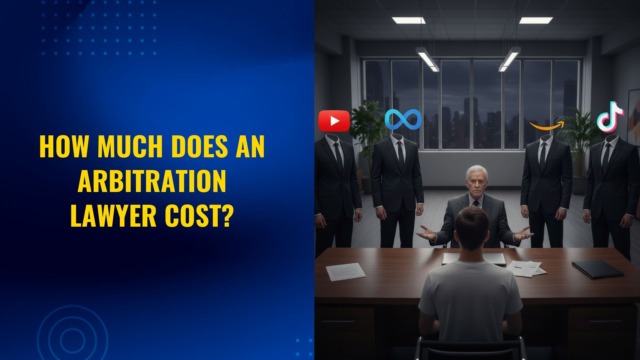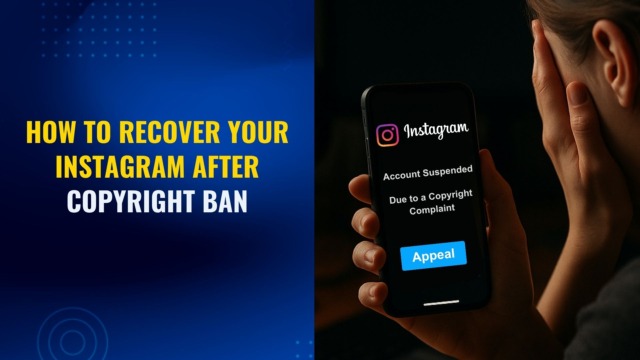
Book a FREE 15-minute consultation with an expert – Book Now
What to Do If Your Shopify Store Is Suspended

Shopify just suspended your store, and now you’re scrambling to figure out what went wrong. Whether you’re a seasoned seller or just getting started, this kind of disruption can be stressful and costly. But don’t panic. In many cases, there’s a clear path to getting your store reinstated.
One moment you’re managing orders and running ads, and the next your storefront disappears with nothing but a warning in your dashboard. This can happen to any type of seller, including dropshippers, private label brands, and print-on-demand stores. The consequences can be serious if you don’t act fast.
This guide explains why suspensions occur, how to recover your store, the necessary documents you’ll need, and when it may be advisable to seek legal assistance.
Is Your Shopify Suspension Permanent?
This is one of the most frequently asked questions we hear from clients, so we’re addressing it right away.
Shopify may use terms like “store termination,” but that doesn’t always mean your store is gone for good. Whether you can recover it depends heavily on why it was suspended in the first place. Some issues like missing documents or minor policy misunderstandings, can often be resolved. Others, such as repeated violations, copyright infringement, or certain high-risk activities, are much harder to reverse.
In most cases, you get one chance to appeal. If your appeal is clear, well-supported, and submitted on time, there’s a strong chance your store can be reinstated.
Timing is critical. Miss Shopify’s deadline or ignore the notice, and the suspension is far more likely to become permanent.
Common Reasons Why Shopify Suspends Stores
While Shopify doesn’t always provide detailed explanations for suspensions, most fall into several clear categories. Knowing these can help you avoid issues before they escalate and protect the long-term stability of your store.
Suspicious Payments or Too Many Refunds
A sudden surge in refund requests, customer complaints, or chargebacks often signals to Shopify that your store may pose a risk. Even if you’re not engaging in fraud, patterns like these can trigger an automated review or manual investigation. If flagged as high-risk, your store could be suspended while Shopify examines the issue.
Selling Prohibited or Regulated Products(without proper permissions)
Violating Shopify’s Acceptable Use Policy by listing banned, counterfeit, or heavily regulated products can result in immediate action. This includes items such as fake branded goods, certain supplements, tobacco products, or digital content that violates content restrictions. Even unintentional violations may lead to suspension, so it’s critical to understand what products are allowed on the platform.
Repeated Copyright or Trademark Complaints
Receiving multiple copyright or trademark complaints is one of the fastest ways to trigger a store suspension. These complaints often arise when you use another brand’s logo, images, product names, or other intellectual property without permission. Shopify generally acts on these reports by disabling your store during the investigation process, especially if there’s a pattern of infringement. This applies whether you’re sourcing your own products or using third-party suppliers.
Failure to Respond to Compliance Requests
Shopify typically gives store owners a chance to provide documentation or clarification before suspending a store. These compliance requests may ask for business licenses, supplier invoices, or identity verification. If you miss the window to respond, either by oversight or delay, Shopify may interpret the silence as non-cooperation and take the store offline. Be sure to check your inbox (and spam folder) regularly for any communication from Shopify.
Problems With Shopify Payments
If your business details don’t align with public records or if there are inconsistencies in your transaction history, Shopify Payments can be suspended. In more serious cases, the store itself may be disabled as well. This can happen if Shopify suspects your billing methods are misleading or if your business model isn’t clearly represented on your storefront. Payment compliance is tightly regulated, so small errors can have big consequences.

How to Understand Why Your Store Was Suspended
Before you can successfully appeal a suspension, it’s important to pinpoint the reason behind it. Here are the key steps to help you identify what triggered the action:
1. Check Your Email for a Suspension Notice
Shopify typically sends an email to your account’s registered address that includes a Ticket ID. This message often outlines the reason for the suspension and provides links to the relevant policies or guidelines you may have violated. Be sure to check your spam or promotions folder in case it was filtered.
2. Log Into Your Shopify Dashboard
Once logged in, look for any banners, alerts, or notifications at the top of your admin panel. These messages may offer clues about what led to the suspension, such as compliance issues or problems with Shopify Payments.
3. Review Recent Store Activity
Think back to any changes made in the last 24 to 48 hours. Did you add a new product, launch a marketing campaign, change your payment setup, or install a third-party app? Suspensions often occur shortly after significant updates that raise red flags.
4. Check for Forwarded Complaints
If your store received a copyright or trademark complaint, Shopify usually forwards a copy of the notice to your admin email. Review your inbox for any messages related to intellectual property infringement or legal disputes. These complaints are a common cause of sudden suspensions.
How to Appeal a Shopify Suspension
Once you’ve identified the likely cause of your store’s suspension, the next step is to file a clear and professional appeal. Follow these steps to increase your chances of a successful review:
1. Use the Appeal Link in Shopify’s Suspension Email
Shopify’s suspension notice will usually include a Ticket ID and a direct link to the appeal form. Always use this link to ensure your case is submitted through the correct channel.
2. Submit the Appeal Form Only Once
Avoid resubmitting the form multiple times. Sending duplicate appeals can slow down the process or cause your case to be flagged as spam. Make sure your first submission is complete and well-documented.
3. Explain the Situation Clearly and Factually
Your message should be professional and concise. Clearly outline:
- What happened
- Why it may have happened
- What steps you’ve taken to fix the issue
Avoid using emotional language, making accusations, or providing vague explanations. Shopify reviewers want evidence and clarity, not speculation.
4. Attach Supporting Documentation
Provide any documents that back up your explanation, such as:
- Supplier invoices or product authentication
- Proof of business registration or licensing
- Screenshots of recent changes
- Customer communication or refunds
This makes it easier for Shopify’s team to verify your claims and move your case forward.
5. Wait for a Response
Shopify typically responds within 3 to 7 business days, although some cases may take longer depending on complexity. Avoid sending follow-ups unless requested, as this may delay the process further.
Example of a Good Appeal
Subject: Appeal for Store Suspension — Ticket ID #123456
Hello Shopify Support,
I’m writing to appeal the recent suspension of my store, [Your brand name].
After reviewing the suspension notice and my recent store activity, I believe the issue may be related to a newly added product: a multi-tool knife. I’ve since removed this item, as I now understand it may violate Shopify’s acceptable use policy regarding regulated products.
To prevent future issues, I’ve reviewed the Acceptable Use Policy and have audited my entire product catalog to ensure full compliance.
Attached are the following:
- Screenshot of the product removal
- Updated product list (CSV)
- Confirmation of compliance review
I appreciate your time and look forward to your response.
Best regards,
[Full Name]
[Email]
Why it works:
- Professional tone
- Identifies the issue clearly
- Explains the action taken
- Includes relevant documentation
- No emotional or defensive language
Example of a Bad Appeal
Subject: My Store Was Unfairly Suspended
This is ridiculous. I didn’t do anything wrong and I demand my store be reinstated immediately. You’re affecting my income and my customers are angry. This is bad customer service and I expect a response ASAP.
Please fix this now.
Why it fails:
- Aggressive and emotional tone
- No details about the issue
- No evidence or documentation
- Demands instead of cooperation
- Shows lack of understanding of Shopify’s process
Supporting Documents to Recover a Suspended Shopify Store
To make your appeal as strong as possible, include documents that directly address the reason for your suspension. The Shopify review team looks for clear, relevant, and verifiable evidence tied to the issue at hand.
If the suspension is due to chargebacks or suspected fraud:
Submit screenshots of your refund policy, details of any fraud-prevention tools you use (like Shopify Fraud Protect or third-party apps), and recent bank or payment processor statements that show legitimate transaction activity.
If the issue involves selling restricted or banned products:
Provide supplier invoices to prove the source of your goods, lab testing reports or certifications (especially for health or safety-related items), and any legal permits or compliance documentation relevant to the products in question.
If you received copyright or trademark complaints:
Submit proof of trademark ownership, any licensing agreements that allow you to use specific intellectual property, or authorization letters from brands or rights holders. If applicable, include communication that shows you had permission to sell or display certain content.
If the suspension is due to identity or business verification issues:
Include a government-issued photo ID, business registration documents, and a recent utility bill or bank statement that shows your business name and address. Make sure all information matches what’s listed in your Shopify account.
Tip: Label each file clearly (e.g., RefundPolicy.png, TrademarkLicense.pdf) and organize them before submitting your appeal. A well-structured set of documents makes it easier for Shopify’s review team to evaluate your case quickly and accurately.
When Should You Talk to a Shopify Suspension Lawyer?
While many suspensions can be resolved through the standard appeal process, there are situations where legal support can make a real difference. You should consider contacting a Shopify suspension lawyer if:
- You’ve lost a significant amount of revenue due to the suspension
- You’re facing intellectual property or fraud allegations, especially from large or well-known brands
- Your initial appeal was denied or ignored
- Your store was shut down without any prior warning or explanation
In these cases, a lawyer can step in to:
- Draft formal, legally grounded responses
- Reference platform policies, consumer protection laws, and relevant case law
- Escalate your case directly to Shopify’s legal or executive teams
At Cabilly & Co., we specialize in helping e-commerce sellers respond to Shopify suspensions, particularly those involving IP claims, compliance violations, or chargeback issues. If you’re facing a suspension and need urgent support, our team is ready to help you take immediate action and work toward getting your store reinstated.
How to Avoid Future Shopify Suspensions
Now that you’ve addressed the current suspension or are preparing your appeal, it’s important to focus on preventing future issues. To protect your store and reduce the risk of getting suspended again, especially for copyright or intellectual property violations, follow these best practices:
1. Regularly Review Shopify’s Acceptable Use Policy
2. Use Fraud Prevention Tools
3. Keep Documentation for Every Product
4. Enable Two-Factor Authentication
5. Respond Quickly to Shopify Compliance Requests
6. Remove Unlicensed or Copyrighted Content
Don’t Lose Hope
Having your Shopify store suspended can be a stressful and frustrating experience, but it doesn’t have to be the end of your business. With the right information, a calm and strategic approach, and proper documentation, many sellers are able to resolve the issue and get back online.
Whether you’re just starting the appeal process or trying to prevent future problems, staying informed and proactive is your best defense. Take the time to understand why suspensions happen, respond professionally, and keep your store in full compliance moving forward.
If you’re unsure about your next step or facing a more complex case, contact us.
Legal Disclaimer: The articles published on our platform are for informational purposes only and do not constitute legal advice in any form. They are not intended to be a substitute for professional legal counsel. For any legal matters, it is essential to consult with us or a qualified attorney who can provide advice tailored to your specific situation. Reliance on any information provided in these articles is solely at your own risk.
Amazon Brand Registry – Discover for Free if You’re Eligible
Increase Your Chance of Getting a
Trademark to 96%
Subscribe to Our Newsletter
Sign up to receive valuable information on E-Commerce and intellectual property

